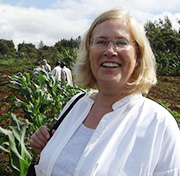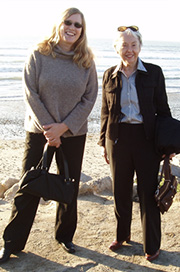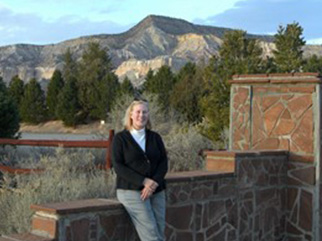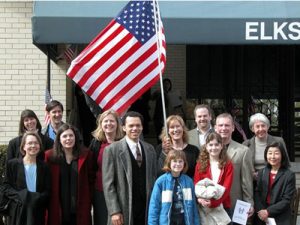
Personal notes, stories, and tributes follow the memorial in the Fall 2022 issue of ASPB News
Share your memories or tributes to Jane in the comments below.
Blake Meyers: I met Jane in 2000, at an NSF PGRP annual meeting when I was a postdoc on one of the earliest-funded projects, and shared an idea with her. She encouraged me to write a proposal, even as a postdoc, which I did. It was ranked “not competitive” with some discouraging comments (“There was also a consensus that this project is not a good step forward on Dr. Blake’s career path”). However, Jane liked the ideas and used her power as Program Director to pull it from the low ranking and fund the project. This 2001 grant then served to launch my career, as I had a funded NSF PGRP project with which to find a faculty position, taking me to the University of Delaware. The project was the first publicly-funded use of next-gen sequencing (“MPSS”); the work built my lab’s informatics capabilities, led directly to the invention of next-gen small RNA sequencing, and allowed me to work with Illumina and their predecessors. Over the years since then, Jane always provided strong encouragement to me and my collaborators, and I will certainly remember her bright, supportive, and positive attitude that was helpful for me as a PI to address and overcome low moments such as criticisms and the numerous difficulties that one faces in science and life.

Scott Jackson: Jane provided mentoring in ways that even the recipient may have been unaware. Early in my career, Jane took a chance on a young PI and provided key advice as I began assembling a team to sequence the soybean genome. Jane later invited me to several NSF panels and seated me next to John McPherson, responsible for advances in physical mapping of the human genome, which led to a friendship and his help with soybean. Years later, I came to realize that Jane had “arranged” our meeting knowing that an outside perspective was needed. Like others, I was a recipient of the Young Investigator Awards that Jane began. This launched my career and my two-decade friendship with Jane. We both loved reading and often exchanged books, first hard copies and later by Kindle. This included everything from bios of Leonardo da Vinci and Keith Richards to Westerns to, most recently, young adult science fiction (Jane was to attend a wedding where the author was a relative). Jane was a great friend and advocate. A source of much advice and many laughs.

Anne Sylvester: I was invited by Machi Dilworth to join Jane as a rotator in the PGRP in 2002 through the exciting and seminal time in plant biology when methods to sequence complex plant genomes were just unfolding. Jane mentored me in the ways of NSF with patience, kindness, and attention; we worked together to develop workshops and meetings to engage the research community in establishing best practices for sequencing the maize genome; we traveled together on outreach trips where impact and inclusivity were key; we discussed on a daily basis “What’s the next big thing? How can we facilitate and support it?” From these conversations and time spent with Jane, I learned the value of collaboration in research and so many other work values that I carry with me today. I marveled at Jane’s scientific insights and ability to coordinate and administer the PGRP, along with her exceptional ability to guide and mentor so many. She embodied a life of learning through travel, reading, and art and of having fun: a co-worker once asked about the boisterous laughter coming from our PGRP office at 8 pm! Jane was a stalwart supporter, mentor, and friend through my own career changes. After her retirement, our friendship continued with a two-person book club and many dinners in-person and on Zoom. The world, and my life, is better for Jane’s presence and impact.

Michael Purugganan: The first time I met Jane was in NSF when she was introduced to me by my then program officer. All I remember was being intimidated by her at that first meeting.
The second time I met her was when she made me do a site visit for NSF in Madison, Wisconsin on the cold, gray weekend after Thanksgiving. I had arrived at my hotel early and so spent the afternoon in my room watching a show on 80s music, not knowing that Jane was in the next room doing the same thing. When we emerged that evening for dinner and found out that we both were watching the same cheesy show, we bonded as friends and have been friends ever since.
The impact Jane had on the direction of plant biology was immense. In her position at NSF, she shaped the modern contours of the field, and her work has transformed the field in so many ways.

I knew her professionally in her role in government, but I also knew her most especially as a dear friend. She wanted to always know about my science, but she also had a caring side that helped me in those moments when I needed a friend. We would meet every year either at NSF or at the annual PAG meeting in San Diego, but we also met up all over the world – in New York (where she came over once to view the Alexander McQueen exhibit at the Metropolitan Museum with me), in Lisbon, and in Singapore. She invited me and my wife to go to Washington several times socially – once to view the cherry blossoms, another to watch the Nutcracker during the holiday season. She read a prayer during my wedding ceremony. My wife Alex said to me that she knew I was a good guy because I had Jane as a friend – and any man who could have a strong woman like Jane as a friend had to be OK.
The last time I saw Jane was virtually in the middle of the first year of the Covid pandemic. I had not heard from her in some time and we spent an hour chatting about all the things we were doing and how busy we continued to be despite the raging pandemic. She was looking forward to resuming traveling, one of the joys of her life.
I will miss Jane more than anything and I cannot really believe she is no longer with us.
Kathy Kahn: Jane had a special knack for encouraging and mentoring others, and I count myself so fortunate to have benefited from her wise counsel. She helped me understand and appreciate the vast opportunities for plant science to lead to positive impact beyond the research lab. Jane was so passionate about what we could do together to benefit smallholder farmers, yet also so clear about our differing roles, with her focus firmly on the basic research end of an “arrow of science” leading to impact. I learned a lot from her about plant science and perhaps more importantly how to foster effective research grants and collaborations. When I think of her, it is with her head back, laughing, exuding enthusiasm.

Machi Dilworth: With Jane’s passing, the world lost the biggest champion of plant biology research, and I lost a best friend. Looking back, having persuaded Jane to join NSF was the most significant accomplishment of my NSF career. From day one, Dr. Mary Clutter, Jane and I worked as a team. Each of us played different roles, and Jane’s was the most important – to keep the quality of science at the highest possible level. If it were not for Jane, the Plant Genome Research Program would not have made as big an impact on plant biology as it has. As a person, Jane was often misunderstood, especially in professional settings, because of her British reserve. The truth is that she was intensely loyal to her staff at work and to her friends in private. Only a few of us knew how Jane took upon herself the responsibility of keeping Mary’s spirit up in her waning years: she carried out the difficult task with genuine affection, respect, gratitude and grace. After my retirement from NSF, Jane and I would talk for hours through FaceTime, with the frequency increasing after Jane’s retirement. I could tell she was truly enjoying her “retirement” life, and I was very happy for her. When I heard the news of her passing, I was preparing to travel to Arlington to spend several days with her. Her sister told me that Jane had prepared new sheets for the guest bed. That is so Jane. I miss her terribly, but I am also grateful for the wealth of wonderful shared memories. Thank you, Jane, and A Hui Hou!!

Dick McCombie: I first met Jane right before she joined NSF. She was on a site visit team for a grant we didn’t get. But when she went to NSF I got to know her. First as a program officer and then more as I served two, five-year terms on the Bio Advisory Committee at NSF. It was there that I saw her tireless support and genuine caring for the plant genomics research community.
She would sometimes ask me to attend meetings where she thought my being there would help in some way, such as the meeting on data sharing in Toronto where she knew I would agree with the Foundation’s position on aggressively sharing genomic data before publication. At another meeting she asked me to attend, she was also in attendance and sitting next to me. At one point she saw me typing on my computer and pull out a credit card. She asked me what I was doing, and I told her I was getting ordained online as a minister and I paid extra to be made a cardinal. Later, we were at a maize meeting in Mexico City and a group of us did some tourist things in the area around the central cathedral in downtown Mexico City. We were walking and I stopped in front of an ecclesiastical clothing store and was staring at a manikin in the window dressed in the full vestments of a Catholic cardinal. Then I heard Jane’s voice behind me, “don’t even think about it”.
At one of the meetings we both attended, Jane literally saved my life. A group of us were walking around in Shanghai at a rice meeting. I wasn’t paying attention and was stepping into the street and felt fingers in the collar of my shirt and was yanked out of the street by Jane as a bus drove by.

We shared many interests. Plant genomics, fine food, and the Devon countryside of her youth among them. As was said of someone else, but also applies to Jane, the world is a less interesting place without her. I’m still in shock she is no longer with us but thank her for the time we spent with her.
Diane Jofuko Okamuro: Jane was a visionary who dedicated her life’s work to advance the plant sciences. She was a valued colleague, mentor, and dear friend to many. She will be sorely missed.

I am not a plant biologist but a microbial ecologist but luckily Jane did not discriminate when it came to mentoring scientists. I interacted with Jane during my two rotations at NSF and in both instances, she was apparently looking out for me, as she did for many rotators. When I first met Jane, she intimidated me as she was a physically imposing woman with great presence. But soon I found myself appointed to a number of high level BARDA committees, around bioterrorism, food security and the vulnerability of our crops and livestock, as this was the period of great paranoia after 911. Although knowing nothing about any of these topics, I soldiered on. I only learned later that it was Jane who had quietly gotten me appointed to these committees. On my second rotation, in addition to having me appointed to a number of OSTP committees, she entrusted me with the very large ARRA portfolio for the BIO Directorate. Again, another topic I knew nothing about (i.e. infrastructure) but she expressed the utmost confidence in me and that gave me confidence as well. Later, I was approached by NIH to head up the new ten-year Human Microbiome Project, which I declined at first. I think Jane was disappointed when I told her I did not feel I had the ‘street creds’ to work with medical doctors. Luckily, NIH extended their offer a second time and this time, I accepted. I learned later that Jane had been the one to recommend me to NIH. Working on the HMP was the capstone experience of my career. Jane somehow knew I would be a perfect fit for this program and for that nudge, I will always be deeply grateful. I retired in 2018 and when I learned she had retired in 2019, we got together a couple of times over dinner to compare notes on retirement. We even exchanged Christmas cards last year and promised we would get together again when the pandemic was (really) over. I missed my chance to see her again and for that, I’m so sorry. I would like Jane’s family, friends and colleagues to know that I’m sure I speak for many scientists at NSF, and especially the rotators, who benefited from Jane’s quiet mentorship and guidance. She will be missed by many. Gratefully, Lita
Hi there! I love this article. It is full of emotion and touching stories that bring us right into Jane’s life, a woman who dedicated her life to advancing plant sciences.
We can imagine how much she was loved, as seen in the admiration of her friends and colleagues who tell of her bravery and kind-heartedness.
I am reminded of the importance of aiming for our goals and living life to the fullest, no matter what tribulations we face.
I believe that Jane’s story is an important reminder to always be grateful for the people in our lives.
It also encourages us to take risks and have courage, even when uncertainty looms.
Her life is a perfect example of how a person can make an incredible impact through dedication and hard work.
Jane was one of my first post-docs and, indeed, one of my first lab members. Before she became the wonderful supporter of plant sciences nationally, for which she is renowned, she was a marvelous bench scientist. This is one aspect of her talents that many people may not be aware of. Her most important achievement in my lab was to develop the methods for isolating intact plant nuclei and using them to demonstrate directly for the first time that phytochrome action resulted in increased transcription of specific genes. Jane also had a sense of fun in the lab, which was in the basement of an old building. She organized other lab members to paint the overhead pipes bright red one weekend, which livened up the otherwise gray environment. Jane’s bench abilities extended to the kitchen. She taught me to make an English Christmas cake, which involved three days of work. It resulted in a beautiful cake that served as a birthday cake as well for my British husband, Philip Thornber, whose birthday was just before Christmas. I feel her unexpected death was not only a shock, but a great personal loss as well as a great loss for the plant community.
I met Jane when she joined Farnham Girls’ Grammar School in 1966. She was a year older than me, but was put into our class, and became my best friend. She was good at the subjects I wasn’t, and excelled at the italic handwriting they forced us to practise. She enjoyed science, particularly Biology, and I remember hours spent in the field above her house, throwing quadrats and counting plant types. But mostly we listened to music and cooked terrible vegetarian dinners. When exams loomed, we ‘studied’ together, at the local outdoor swimming pool. We went to Paris together, when I was 15, with her mother as chaperone, though we hardly saw her, staying in a cockroach-ridden hotel on the left bank, which Jane returned to on honeymoon some years later, when it had been totally transformed. The following year, we went, unaccompanied, to Rome, where we stayed in a monastery and existed for a week on bread rolls and watermelon. So much of my teenage life was spent with Jane, and we remained close when we went on to university, me in London and her in Brighton. I was a witness at her wedding and we regularly visited each other until she moved to the US. For 50 years, I have unfailingly received cards from Jane at Christmas and my birthday in July, each one accompanied by a handwritten letter, in perfect italic, giving news of her work and her travels. I shall miss her infectious laugh, and her amazing friendship.
I was saddened to learn that Jane had died. I knew her in the 1970s, when she was living in Farnham, Surrey, and during her years at the University of Sussex. We lost touch after that. But, through the internet, I was able to follow her impressive and successful career. Jane was a very kind person. I have fond memories or her, and I shall forever value the time she shared with me. She will be greatly missed.
I met Jane in 2021 when I began working at the Supporters of Agricultural Research Foundation (SoAR Foundation). She was incredibly dedicated to science, agricultural research and making the world a better place, especially in the developing world. I was always inspired by her intellect and willingness to work hard on the issues she believed in – all of us and the agriculture science world misses her greatly.
I was terrified of Jane when I first met her, in my first weeks at NSF. But I later came to realize that was just her British way. She mentored me, advocated for me, and provided me with some of the best advice I ever got – both personally and professionally. She was devoted to NSF and the science community it served. She had keen insight into people. I will always be grateful to the ways she impacted my life and my career and for all she did for the science she loved.
I met Jane when I interviewed to be a rotating program director at NSF. She was very gracious, and clearly a strong leader. Jane was good at explaining complicated ideas clearly and seeing the scientific horizon, skills which she used to influence the planning for new areas of scientific investment to serve the Nation as a program director and later a senior manager. As a leader at NSF, Jane ran a tight ship which combined with her British reserve led some to find her intimidating. Few people at NSF knew just how deeply Jane cared about those she led. Just as she mentored so many in the scientific community, Jane also worked to develop people inside NSF. She offered individuals opportunities to grow and excel, adjusting her level of guidance to their needs and goals and taking time to mark their achievements. Some of these folks were rotating program directors who returned to academia and became leaders on their campuses. Some were NSF staff who learned to lead, no matter what position they held. Some of these folks, including me, became the next generation of leaders in the Directorate, one more part of her legacy.
I first met Jane in 1985 at a Photobiology Meeting in Los Angeles, where she was a postdoctoral fellow in Elaine Tobin’s lab. Although I remember visiting Jane in Elaine’s lab for a whorl wind tour, Jane and I developed a special bond during a bus excursion in Japan following the XVI’s Yamada Conference in October 1986. There were 15 of us crammed into the bus that was equipped with cushy, movable couches which could be reconfigured to encourage conversations with all on board. As trapped participants on that bus – who included Winslow and Ann Briggs, Tony Cashmore, Peter Quail, Masamitsu Wada, Manfred Kraml from Erlangen, Heidi Marie Oelze-Karow and Helga Drumm from Han’s Mohr’s laboratory in Freiburg, Bill Van der Woude from USDA, Jim Tokuhisa – a student in Peter Quail’s Lab, amongst others – we got to learn a lot about each other (aside from science). From those days forward, Jane and I kept in contact as our two careers unfolded. When she set up her new laboratory at UC Santa Cruz, we bonded over the struggles to finding one’s niche scientifically and how to convince the established leaders in the phytochrome field that our projects were significant enough to publish or to compete successfully for funding. I remember Jane telling me that she received the criticism that her work on gingko photomorphogenesis was going nowhere at the same time I received the criticism that “no one but my lab believed that phytochrome was a kinase.” We both felt a little better after those conversations. Those experiences underscore Jane’s approach to funding young investigators and welcoming new ideas that challenge paradigms after she joined the NSF. Indeed, Jane was a master at putting herself in the shoes of others and showing empathy for the struggles of the young scientist. I will greatly miss Jane’s scientific insight but especially her lack of pretension, keen wit and friendship. Clark